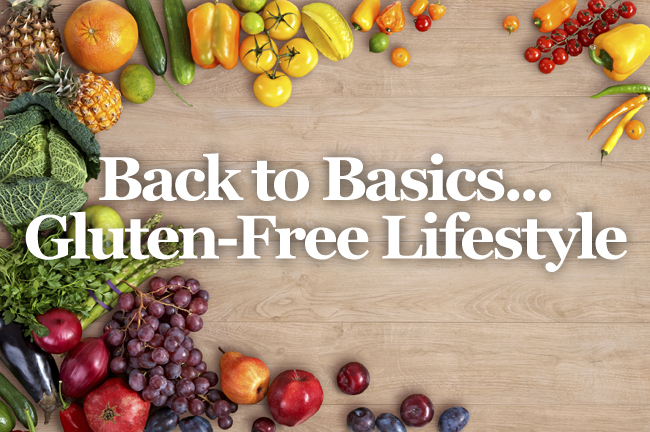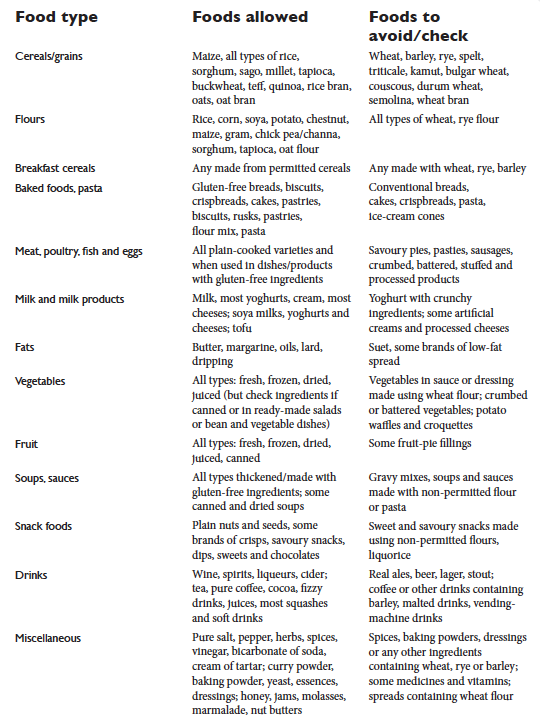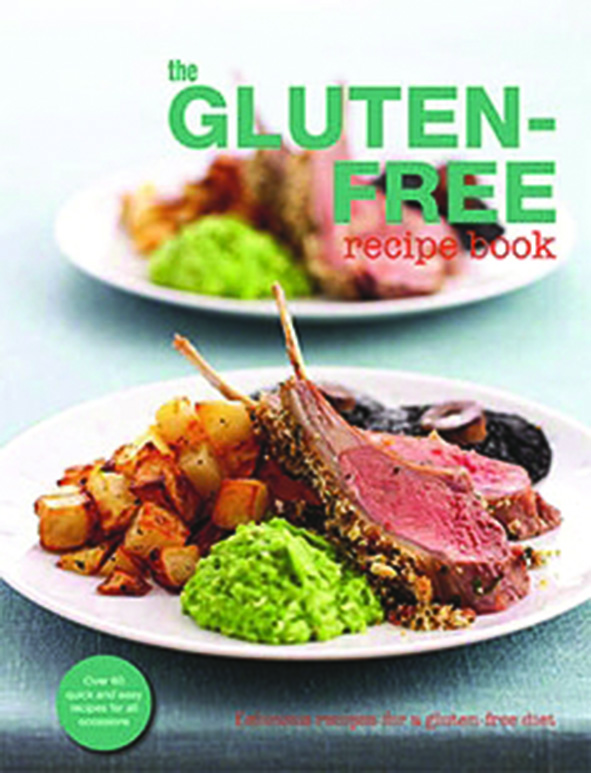Take a moment to review what’s understood about coeliac disease and revisit the foundations of the gluten-free lifestyle, with Lyndel Costain’s checklist of safe foods and those to avoid…

Gluten is a type of protein found in grains including wheat, barley and rye. Gluten becomes sticky and malleable when combined with water, making it ideal for bread-making and baking.
What is coeliac disease?
Coeliac disease can develop at any age, but it is most commonly diagnosed in people aged between 40 and 50. When people with coeliac disease eat gluten containing foods, their immune system fights the gluten, causing inflammation of the delicate cells lining the small intestine. In the process, the villi – finger-like projections necessary for the absorption of nutrients and fluids from food and drink – become flattened and cannot do their job properly, causing digestive and nutritional upsets.
In recent years many people who do not suffer from coeliac disease have opted for a wholly or partially gluten-free diet because of the perceived health benefits, although there is no evidence to suggest that eliminating gluten from your diet has any health benefits if you are not gluten intolerant.
Following a gluten-free diet
When switching to a gluten-free diet, it may initially seem that there is nothing you can safely eat. A gluten-free diet rules out all ordinary baked goods, pasta and many convenience foods such as gravies, soups and sauces. This is because gluten is used as an additive in a wide number of foods including, for example, ice cream and ketchup. Careful thought needs to be given to shopping for and preparing gluten-free meals, but there are many wonderful foods that are naturally gluten-free and can be used to make delicious meals.
As with all diets, being organised is the best approach to ensure you eat well. Planning meals in advance, shopping with a list of foods you are allowed, reading food labels and cooking meals from scratch will all help to make life easier and ensure a balanced, varied and satisfying diet.
Naturally gluten-free foods
There are a number of ingredients that can form the basis of a gluten-free diet that is full of flavour and variety. These include:
- Fruit and vegetables
- Unprocessed meat, poultry and fish, including shellfish
- Unprocessed cheeses, butter, milk, cream and natural yoghurt
- Eggs
- Tofu
- Cooking oils
- Sugar, bicarbonate of soda, cream of tartar and yeast
- Plain nuts, seeds and pulses
- Rice and its products, including rice flour and rice noodles
- Gluten-free grains and their products such as buckwheat noodles and flour and polenta
- Vinegars, herbs and spices
What about alcohol?
Gluten-free drinks include wine, champagne, cider, spirits, liqueurs, port, vermouth and sherry but all beers, lagers, stouts and ales must be avoided.
Hidden ingredients
It is important to get into the habit of always checking the label for hidden gluten. The following ingredients are important to watch out for, and may indicate that a product contains gluten:
- Barley
- Bran
- Breadcrumbs
- Bulgar or cracked wheat
- Cereal extract, cereal binder
- Cracker meal
- Durum
- Farro
- Farina
- Kamut
- Modified starch
- Rusk
- Semolina
- Spelt
- Vegetable gum, vegetable protein, vegetable starch
- Wheat bran, wheatgerm, wheat starch
- Wheat, wholewheat
Storecupboard essentials
In addition to all the gluten-free foods mentioned above, if you look out for and stock up on these specialist ingredients, you can make a wide range of mouthwatering gluten-free recipes.
Flours
There are gluten-free flours that can be used for making and cooking, such as rice, chickpea, corn, soya, buckwheat and millet. If your local supermarket doesn’t stock them, you can find them at health food stores or online.
Xanthan gum
This powder is a huge help in gluten-free baking as it replaces, to some extent, the elastic qualities that gluten-free flours lack. Adding it to these flours makes bread less crumbly and pastry easier to roll and handle. You’ll find it in some supermarkets, online and in health food stores.
Gluten-free baking powder
Standard baking powder contains gluten, so you’ll need gluten-free for baking. It is now widely available in the baking aisle of supermarkets.
Pasta and noodles
Gluten-free pasta is becoming more common and you’ll find it in most supermarkets. Rice noodles and the varieties of soba noodles made entirely from buckwheat are naturally gluten free.
Grains
Quinoa is a great addition to any diet, providing an excellent source of protein in addition to being gluten-free. It is a good substitute for couscous or bulgar wheat in salads. Polenta is good for baking and can be used as an alternative to breadcrumbs for coating.
Cheese and dairy products
Unprocessed cheeses are gluten-free, as is milk and unflavoured yoghurt, so these are worth keeping on hand.

Eating out
Check the menu carefully for hidden gluten, especially in sauces and coatings (such as breadcrumbs). Many chefs are happy to cook something off-menu to suit you.
Can I eat oats?
Most people with coeliac disease can eat gluten-free oats. However, many brands of oats are produced in the same place as wheat, barley and rye, which makes them unsafe, so check that they are guaranteed gluten-free.
Beware contamination
As well as avoiding obvious sources, it is important to ensure your gluten-free foods are not cross-contaminated by others that contain gluten. For example, shop-bought meringues are likely to have come into contact with gluten containing cakes, while chips from a fish and chip shop may have met with batter in the deep-fat fryer. Make these simple steps part of your daily routine:
- Store gluten-free flours separately.
- Use separate spoons, knives and chopping boards to prepare gluten-free food.
- Keep separate equipment, such as rolling pins, pastry brushes and sieves, for gluten-free baking.
- Wash everything well and clean surfaces before cooking and eating.
- Never share breadboards, toasters or butter dishes with users of standard bread.
 Extract taken from The Gluten-Free Recipe Book by Lyndel Costain, published by Bounty (RRP £9.99). www.octopusbooks.co.uk
Extract taken from The Gluten-Free Recipe Book by Lyndel Costain, published by Bounty (RRP £9.99). www.octopusbooks.co.uk
